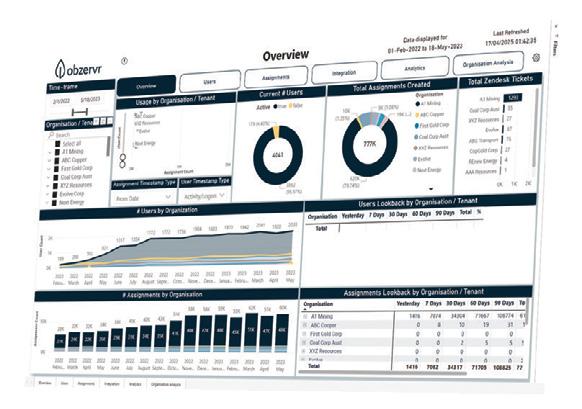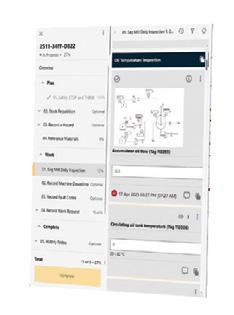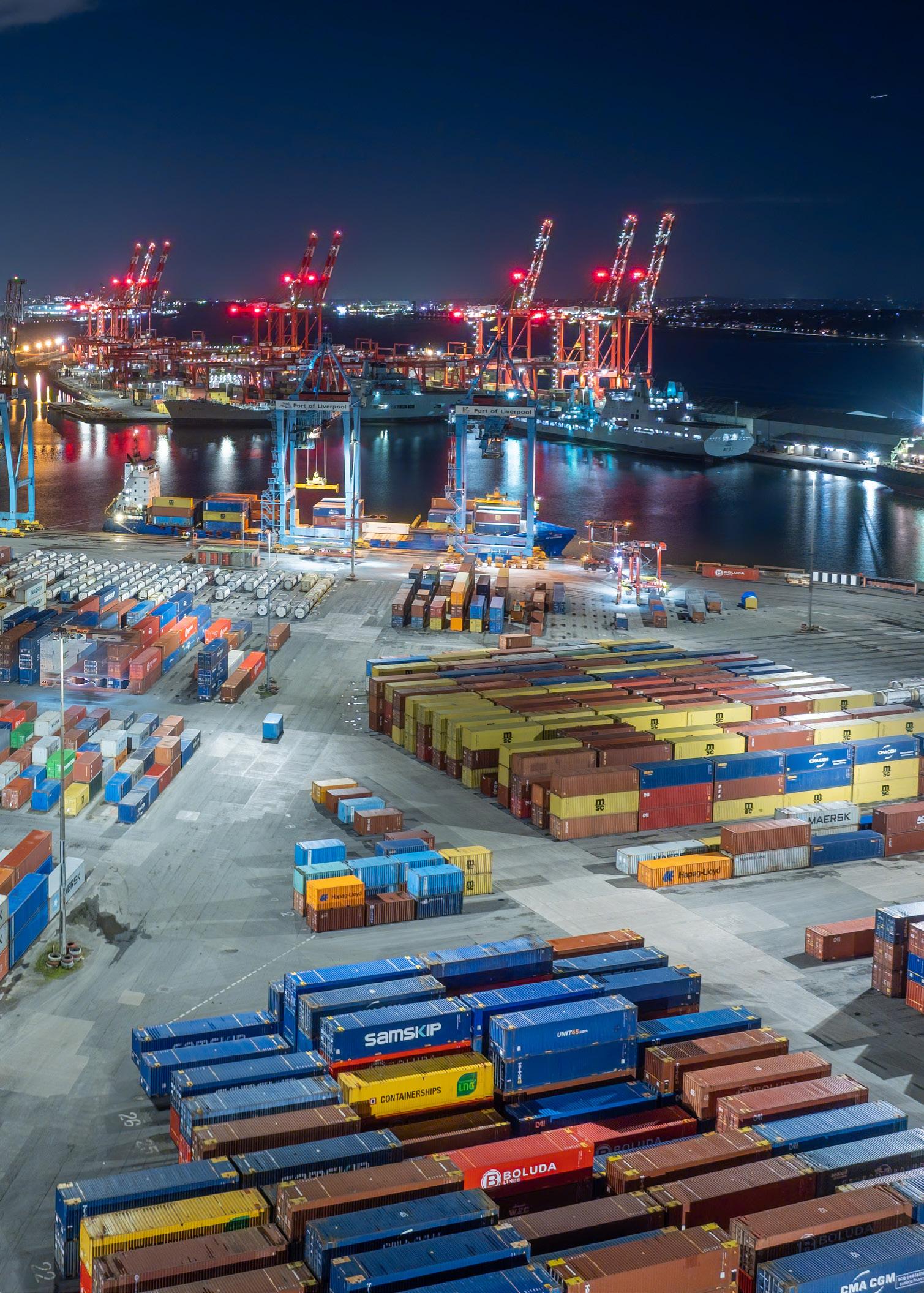

The State of ASSET MANAGEMENT in
West Australia
The Obstacles to Achieving Asset, Maintenance, and Reliability Management Excellence
For nearly three decades, the MAINSTREAM research team has engaged with West Australian-based Asset, Maintenance, and Reliability leaders to understand their collective challenges and opportunities as they work toward asset management excellence. The 2026 report presents the most pressing obstacles facing organisations today based on extensive research including roundtable discussions, surveys, and in-depth interviews.
This year’s findings reveal a shifting landscape where traditional challenges persist alongside emerging complexities. Organisations continue to struggle with workforce transitions, data integration, and organisational alignment, while facing pressures from digital transformation projects, decarbonisation initiatives, and evolving stakeholder expectations.
The insights gathered in this report enable leaders to benchmark their challenges against peers, understand best practices, and make informed decisions that drive performance improvements within their asset management functions.

Report Highlights
Data Overload Crisis
78% of organisations collect more data than they can analyse, creating barriers to effective maintenance decision-making
Critical Skills Shortage
Australia facing 25,000 professional deficit by 2027, compounded by 37% of technical knowledge being undocumented
AI Implementation Failures
While 72% have explored AI applications, 76% fail to achieve expected returns due to infrastructure limitations and cultural resistance rather than technology problems
Strategic Misalignment
Persistent disconnect between corporate objectives and maintenance execution, limiting asset management effectiveness and business value demonstration
Diversity Barriers
Women represent only 16.8% of maintenance workforce while diverse teams achieve 19% higher innovation revenue and 11% better project delivery
Technology Integration Struggles
Despite 83% investing in digital technologies, only 34% achieve expected ROI with organisations operating 8-12 separate asset information systems
Decarbonisation Pressure
Complex hybrid portfolio management challenges as organisations transition from traditional to low-carbon technologies while maintaining operational performance
Workforce Wellbeing Crisis
Maintenance professionals experience mental health challenges 23% higher than general workforce, particularly affecting FIFO and remote operations
Budget Constraints
Organisations receive “unidentified savings” mandates without guidance, creating tension between short-term costs and long-term sustainability
Safety Integration Gap
27% of serious incidents have maintenance factors, yet only 31% achieve integrated safety-asset management despite 47% fewer incidents with integration
Reliability Engineering Undervaluation
Role confusion and limited organisational influence restrict systematic improvement, requiring reframing as “business performance optimisation”







About the research
The findings presented in this report are drawn from:
1. Five facilitated roundtable discussions with 79 senior maintenance and reliability professionals
2. An online survey completed by 113 professionals across diverse industries
3. 14 one-on-one interviews with heads of asset management, maintenance, and reliability
4. Analysis of industry data and global benchmarks
Participants represented WA-based organisations, including companies in mining, utilities, oil and gas, manufacturing, rail transportation, infrastructure, defence, and public sector.
Authors
The comprehensive survey content presented in this report was meticulously designed, developed, and authored by The MAINSTREAM Research team. As a leading research authority in the ANZ region, MAINSTREAM brings decades of collective experience and methodological rigour to this analysis. The authors acknowledge Obzervr for their invaluable partnership and support throughout this research initiative.
MAINSTREAM Summit
The results of the survey directly influence the MAINSTREAM WA Summit program. This means that the speakers (local and international), workshops and masterclasses at the MAINSTREAM WA Summit on the 18th March 2026, will be relevant to the community’s knowledge, capability, and training requirements.
Companies Represented
Thank you to the following organisations for participating:
Alcoa of Australia
Anglo American
AngloGold Ashanti Australia
ASC
Aurizon
Australian Gas Infrastructure Group
BAE Systems
Beach Energy
BHP
Byrnecut
CBH Group
Chevron
Covalent Lithium
CSBP Wesfarmers
Department of Defence
Energy Queensland
Evolution Mining
Fortescue
Fremantle Ports
GMA Garnet
Gold Fields
Iluka Resources
Inpex
Macmahon
Main Roads Western Australia
Mid West Ports Authority
Mineral Resources
Newmont Mining Corporation
Northern Star Resources
Petrofac Australia
Pilbara Minerals
Pilbara Ports
Public Transport Authority of WA
Qube Holdings
RCR Mining Technologies
Rio Tinto
Roy Hill
Royal Australian Navy
Santos
Shell QGC
South32
Southern Ports
Spotless Group
Synergy
Talison Lithium
Transdev Australasia
Virgin Australia Regional Airlines
Water Corporation
WesCEF
Western Power
Woodside Energy

Individual Voices: #1 Challenge
The research team asked participants to identify their single most significant challenge preventing achievement of maintenance and reliability excellence. This is a selection of unfiltered responses, providing authentic insights into the daily realities facing asset management professionals across Western Australia:
“Lack of knowledge of the basics of asset management and what good looks like.”
Highlighting fundamental capability gaps that persist despite industry maturity
“Our systems are not fit for purpose and don’t deliver accurate data.”
Reflecting widespread frustration with technology investments that fail to deliver promised benefits
“Our biggest challenge is overcoming labour constraints, ensuring strict adherence to processes, improving quality of work, and enhancing the asset management and maintenance expertise of both engineers and leaders.”
Demonstrating the multifaceted nature of excellence barriers
“Clearly articulating asset & maintenance debt risk”
Emphasising risk communication challenges
“A lead barrier is poor asset information foundation, creating knowledge gaps in understanding the assets we own and the condition they’re in. This combines with poor work management practices and fragmented engineering silos.”
Showing how multiple challenges compound each other
“Data Quality. Aligning what has been executed in the field with accurate cause and remedies.”
Emphasising the persistent disconnect between data collection and actionable intelligence
“Retention of skilled workforce, and improving asset reliability. Seeking technological solutions for efficiency gains.”
Highlighting the interconnected nature of workforce and technology challenges
“Previous business decisions resulting in current maintenance debt. Aggressive export targets restricting maintenance access.”
Capturing the long-term consequences of short-sighted decision-making
“Balancing effective asset risk management with network performance outcomes and resource availability (labour and cost).”
Illustrating the complex trade-offs facing resource-constrained organisations
“Leveraging technology to drive improvement where it matters most. Too many options, too many glossy brochures which don’t deliver. How do we know what works and stay the course to deliver the result? ”
Capturing technology overwhelm and vendor fatigue
“Languages & culture differences”
Reflecting the multicultural challenges in Australia’s diverse workforce
“Battery Energy Storage Systems (BESS) are increasingly critical to grid stability and energy transition, yet the reliability analytics and Asset Performance Management frameworks for these assets remain underdeveloped.”
Highlighting emerging technology challenges
“A lack of clear unifying business strategy – each group entity pretty much approaches AM their own way.”
Emphasising strategic alignment challenges across organisations
“Stakeholder understanding of good asset management and the impact of poor maintenance practices on getting the best life from assets.”
Reflecting stakeholder education needs
“Having confidence that the maintenance being done in field aligns with the strategies. A lot of different teams involved – Engineering, Maintenance execution, Reliability, high value work centres”
Reflecting execution versus strategy disconnects
“Cost – being able to justify the right budgets to upskill teams, install innovative technology and maintain to the right standards.”
Capturing investment justification struggles
“Budget constraints across mature assets. Extending asset lifecycle without compromising integrity and reliability.”
Reflecting the challenge of ageing infrastructure and financial pressures
“We focus heavily on technical safety systems and compliance documentation, but we rarely address the human factors that cause good maintainers to make errors under pressure. Even experienced people make mistakes they’d never make under normal circumstances.”
Highlighting the gap in human error management
“Personnel – trying to get a large variety and demographic of people and disciplines to standardise the way we manage our CMMS and conduct work.”
Highlighting human factors in standardisation efforts
“Balancing the contrasting requirements of our company values for safety, responsibility etc and KPIs for production, OPEX, CAPEX across a set of global operations.”
Capturing competing priority tensions
“Being able to standardise work processes and also being able to provide greatest value optimisation of reliability strategies with limited resources.”
Capturing the standardisation versus optimisation tension
“Silos”
A simple yet powerful description of organisational fragmentation
“Communication of metric impacts on business performance.”
Highlighting the translation gap between technical and business domains
“The challenge is to achieve the same level of AM across multiple different sites nationally. There’s currently too much difference in AM standards across the sites.”
Highlighting multi-site standardisation challenges

The Twelve Critical Challenge Domains
Executive Summary
The twelve challenge domains identified through extensive industry engagement demonstrate that achieving maintenance and reliability excellence requires understanding these issues as an integrated system rather than isolated problems.
When organisations attempt to address data quality without considering workforce capabilities, or implement new technologies without strengthening work management fundamentals, the results consistently fall short of expectations.
The challenges span five distinct but interrelated categories that collectively determine organisational success. Strategic challenges around business alignment and performance measurement create the foundation for all other improvement efforts. Macro-level pressures including budget constraints, skills shortages, and decarbonisation requirements, reshape the operating environment in which maintenance teams must deliver results. Digital transformation issues encompassing data management, system integration, and artificial intelligence adoption present both opportunities and implementation complexities that organisations struggle to navigate effectively. Core maintenance work management challenges around standardisation, planning effectiveness, and reliability engineering remain central to operational excellence despite decades of industry attention.
Perhaps most critically, human factors pervade every aspect of asset management excellence, from workforce wellbeing and diversity through to knowledge preservation and safety integra-
tion. The research consistently demonstrates that technology and process improvements fail without addressing the human elements that ultimately determine whether standards are followed, systems are adopted, and improvements are sustained. The interconnected nature of these human challenges means that organisations cannot achieve lasting excellence while treating workforce issues as secondary concerns.
At the heart of these challenges lies Western Australia’s industrial workforce – the Reliability Heroes who maintain the critical infrastructure that powers the state’s economy. These professionals face pressures from ageing assets, evolving skill requirements, geographic isolation, and increasing performance expectations while often lacking the organisational support, resources, and recognition necessary for sustained excellence.
Their expertise, dedication, and resilience represent the foundation upon which all technological and strategic improvements must build. Recognising and supporting these Reliability Heroes is not merely a human resources consideration but a strategic imperative that determines whether organisations can successfully navigate the complex challenges ahead.
Data Governance, Quality and Utilisation
The most pervasive challenge across all sectors involves organisations drowning in poor-quality data while struggling to extract strategic value for decision-making.
This fundamental paradox emerged consistently across individual responses and group discussions, with organisations specifically identifying “data quality” and “aligning what has been executed in the field with accurate cause and remedies” as primary challenges.
Organisations report unprecedented data collection capabilities coupled with limited ability to transform information into actionable insights. The challenge transcends simple volume management to encompass fundamental questions about data purpose, quality standards, and governance frameworks. As one participant articulated: “We are replacing the Excel icon when everyone’s doing 5 pivot tables. Now it’s just with a Power BI icon. The problem is the same, it’s just really defined differently.”
Data Quality vs. Quantity Crisis
The most significant manifestation involves organisations collecting vast quantities of information without corresponding improvements in decision-making capability. Multiple participants reported that maintenance professionals spend substantial time searching for, validating, or reconciling data across multiple systems, representing significant productivity loss despite organisations investing heavily in data collection technologies and analytical tools.
The research revealed a compelling analogy that captures this challenge perfectly: organisations approach data like diners at an unlimited buffet, loading their plates with everything
available but lacking the appetite or capacity to consume what they’ve collected. Data accessibility has paradoxically created decision paralysis rather than improved decision-making.
The challenge extends beyond collection to encompass data completeness and historical continuity. The transition from physical filing systems to digital platforms has often resulted in the loss of contextual details that were previously preserved in manual records. This transition loss affects organisations’ ability to understand long-term asset performance trends and make informed lifecycle decisions.
Industry Voices on Data Challenges
Leading maintenance professionals across Western Australia report similar frustrations. A reliability engineer from a major mining operation observed: “We’re generating more data than ever before – vibration readings, oil analysis, thermal imaging – but our team spends more time chasing data quality issues than actually preventing failures. The irony is that we have less confidence in our decisions now than when we had simpler systems.”
A maintenance manager from the energy sector described the cultural impact: “Our technicians have become data clerks. They’re so focused on feeding the system that they’ve stopped thinking about what the equipment is telling them. We’ve lost that intuitive understanding that comes from really knowing your assets.”
One water utility engineer highlighted the downstream effects: “Bad data doesn’t just affect today’s decisions – it corrupts our predictive models, undermines our root cause analyses, and erodes trust in the entire maintenance management system. Once people lose faith in the data, they start keeping their own records, and then you really have chaos.”
These challenges resonate beyond Western Australia. Recent MAINSTREAM research indicates that maintenance professionals spend approximately 38% of their time on data-related activities rather than value-adding work, with 78% of organisations collecting more data than they can effectively analyse. The pattern suggests systemic industry-wide issues with data governance that go beyond regional variations in technology adoption or organisational maturity.
Governance and Direction Deficits
Multiple organisations lack systematic approaches to data prioritisation and governance, resulting in collection efforts disconnected from business decision requirements. The absence of clear data governance frameworks means organisations accumulate information without corresponding capabilities to extract value.
Decision-making clarity represents another critical gap, with unclear expectations about what decisions stakeholders should make based on available data. The research consistently identified organisations asking fundamental questions about data purpose – what problems they’re trying to solve, why they’re collecting specific information, and what decisions should result from the analysis. These fundamental questions often remain unanswered, resulting in data collection efforts that fail to support actual organisational needs.
IDEAS & SOLUTIONS
• Start with the Decision, Not the Data
Instead of collecting everything possible, map out the five most critical decisions your maintenance team makes weekly and work backwards to identify what data actually supports those decisions. Most organisations find they need far less data than they’re collecting, but it needs to be of higher quality.
• Implement the 80/20 Rule for Data Quality
Focus intense effort on getting 20% of your data absolutely right – the critical equipment, key failure modes, and essential performance indicators. Perfect data on your top 50 assets is infinitely more valuable than poor data on 500 assets.
• Create Data Champions, Not Data Clerks
Assign experienced tradespeople and engineers as data quality champions rather than treating data entry as an administrative task. When someone who understands the equipment validates the information, quality improves dramatically and the data actually gets used for decision-making.
• Use Visual Data Validation
Display data trends on screens where the work actually happens. When maintenance teams can see their own data being used in real-time dashboards, they take ownership of quality. Bad data becomes obviously wrong when it’s displayed publicly.
• Build Simple Feedback Loops
Show teams how their data entry directly impacts work planning and parts ordering. When planners can demonstrate that good failure codes led to faster repairs or better parts availability, data quality becomes a shared responsibility rather than a compliance exercise.

78% of organisations report collecting more data than they can effectively analyse
System Integration and Technology Transition
Organisations face substantial difficulties integrating disparate systems and managing technology transitions, particularly affecting data accessibility and work management effectiveness.
This challenge emerged prominently in individual responses, with organisations highlighting the widespread struggle with enterprise system transitions.
System Fragmentation Complexity
Organisations typically operate 8-12 separate systems containing critical asset information, with one organisation reporting over 3,000 software applications across their operations. This fragmentation creates significant inefficiencies, with maintenance technicians spending substantial time navigating between different information systems.
System integration challenges extend beyond technical compatibility to encompass data consistency, user experience design, and workflow optimisation. Organisations moving from legacy systems to modern platforms frequently experience data capture degradation during transitions. Research revealed significant drops in data recording quality following major system implementations, with previously mandatory fields becoming optional and comprehensive data entry practices being abandoned in favour of simplified but less informative approaches.
Technology
Transition
Management
The transition from legacy systems to contemporary platforms creates unique challenges requiring careful change management and capability development. Organisations often
underestimate the complexity involved in maintaining data quality and user adoption during system implementations. The identification of barriers including “lack of consistency, reactive culture, value of reliability not understood” reflects common organisational readiness challenges that technology alone cannot resolve.
Successful technology transitions require systematic attention to process design, user training, and data migration strategies. Organisations achieving effective transitions typically invest substantial effort in change management activities that support user adoption and maintain operational continuity during implementation periods.
IDEAS & SOLUTIONS
• Run Parallel Systems During Transition
Keep the old system running read-only for at least six months after going live with new technology. This gives users confidence and provides a safety net for retrieving historical information while they adapt to new workflows.
• Train Super Users from the Tools, Not IT
Select your best tradespeople and planners as system champions. Train them intensively, then have them train their peers. Technical people teaching technical people works better than IT staff explaining maintenance workflows they’ve never performed.
37% of technical knowledge is reportedly undocumented

• Start Small and Prove Value
Pick one critical piece of equipment or one maintenance crew for initial rollout. Perfect the system configuration and processes with this small group before expanding. Success stories from respected peers carry more weight than management mandates.
• Design for the Field, Not the Office
Configure systems for how work actually happens – on mobile devices, in noisy environments, with gloved hands. If the system doesn’t work where maintenance actually occurs, it won’t be adopted regardless of its sophistication.
• Map Every Integration Point
Document how information flows between systems before starting any integration project. Hidden dependencies always surface during implementation, and knowing them upfront prevents costly delays and workarounds.
Work Management Standardisation and Consistency
Despite standardised processes existing for decades, compliance and execution remain inconsistent across sites and teams, creating one of the most persistent challenges facing multi-site organisations.
This challenge transcends simple process documentation to encompass fundamental questions about human behaviour, accountability mechanisms, and organisational culture.
Technology Doesn’t Equal Standardisation
Research revealed a fundamental misconception captured by experienced practitioners: the belief that implementing standardised systems will automatically generate standardised practices represents a costly illusion that has disappointed many organisations pursuing technology-driven standardisation initiatives.
The illusion stems from treating standardisation as a technology problem rather than a human behaviour challenge. Organisations consistently discover that deploying standardised systems doesn’t automatically generate standardised practices, particularly when underlying accountability mechanisms and cultural factors remain unchanged.
The Human Element and Accountability Factor
The research identified a critical distinction between measurement and accountability that determines standardisation success. Organisations that achieve compliance have discovered the importance of sustained accountability –measuring metrics consistently while maintaining real consequences for non-compliance. In contrast, “forgiving” environments where measurement occurs without follow-through fail to drive behavioural change.
The emphasis on process discipline and accountability demonstrates that successful standardisation requires systematic attention to human factors rather than relying solely on system implementation. Technology provides the framework, but human behaviour determines whether standards are actually followed.
Geographic and Cultural Challenges
Western Australia’s distributed workforces across vast geographical areas create unique standardisation challenges compounded by varying levels of technological literacy, different operational preferences, and entrenched local practices. Organisations must develop “core, common, and specific” approaches that maintain essential standards while accommodating necessary local variations.
Work Management Maturity Gaps
Research revealed that newer sites often lack comprehensive training in established processes, resulting in learning approaches that mimic visible behaviours without understanding underlying principles. The observation that “sites don’t actually know what good looks like” reflects a fundamental knowledge gap where poor practices become normalised simply through repetition and lack of external benchmarking.
Physical asset standardisation creates additional complexity when standard designs are delivered to sites with non-standard existing infrastructure, creating persistent mismatches between local and business standards that undermine overall consistency.

Organisations consistently discover that deploying standardised systems doesn’t automatically generate standardised practices
IDEAS & SOLUTIONS
• Define Your Non-Negotiables
Identify the 5-10 critical processes that must be standardised everywhere –usually safety-critical procedures and key data entry requirements. Everything else can be locally adapted. Most organisations try to standardise too much and end up standardising nothing effectively.
• Make Standards Visible and Simple
Put critical standard procedures on laminated cards at the point of work. If someone can’t execute a standard process with a single page of instructions, the standard is too complex. Visual standards work better than detailed manuals that nobody reads.
• Rotate People Between Sites
The fastest way to spread good practices is to move experienced people between
locations for 3-6 month assignments. They become change agents who can demonstrate better ways of working while adapting standards to local conditions.
• Create Internal Benchmarking
Organise quarterly visits between similar sites to share practices and compare performance. Nothing motivates improvement like seeing peer sites doing better work with the same resources and constraints.
• Standardise Training, Not Just Procedures
Develop consistent training methods and competency assessments even if work practices vary slightly between locations. When everyone learns the same foundation skills, local variations become adaptations rather than deviations.
Financial Justification and Resource Allocation
Organisations face mounting pressure to deliver more with the same or fewer resources while managing increased operational complexity. This challenge extends beyond simple cost-cutting to encompass fundamental operational changes required for industry transitions.
Organisations’ challenges of “being able to justify the right budgets to upskill teams, install innovative technology and maintain to the right standards” exemplify widespread struggles to secure appropriate resource allocation. Another common focus on “clearly articulating asset and maintenance debt risk” reflects difficulty translating technical requirements into business language that secures necessary funding.
Unidentified Savings Mandates
Organisations frequently receive budget reduction requirements without implementation guidance. The research uncovered widespread frustration with “unidentified savings” allocated into budgets without clear direction on achievement methods, forcing reactive cost reduction without strategic consideration of operational consequences.
Transformation Without Additional Resources
Carbon neutrality objectives illustrate complexity beyond simple cost-cutting: achieving “Real Zero before 2030” cost-neutral while transitioning from diesel to electric mining equipment, requiring workforce transformation from mechanical to electrical skills while managing dual asset types during transition periods.
The tension between historical business decisions and current operational demands captures fundamental conflicts between short-term operational demands and long-term asset sus-
tainability. Aggressive production targets often restrict maintenance access precisely when asset condition requires increased attention.
Successful Resource Optimisation Approaches
Research identified successful implementations of zero-based budgeting using ERP system modelling that achieved acceptance without organisational challenge due to transparency and systematic methodology. The approach of using analytical algorithms to rebuild maintenance activities with reduced staffing levels, when presented with clear methodology, gained business acceptance that traditional budget-cutting approaches could not achieve.
IDEAS & SOLUTIONS
• Use Total Cost of Ownership Arguments
Stop arguing for maintenance budgets based on compliance or best practice. Instead, show executives the total cost impact of different maintenance strategies over 3-5 years, including production losses, emergency repairs, and asset replacement costs. They understand business cases better than maintenance philosophies.
• Implement Zero-Based Activity Reviews
Challenge every maintenance activity to justify its existence based on risk and cost. Often you’ll find 20-30% of planned
Organisations frequently receive budget reduction requirements without implementation guidance.

maintenance adds little value while critical tasks are under-resourced. Reallocating existing budgets can be more effective than requesting increases.
• Create Visible Maintenance Debt Tracking
Maintain a public dashboard showing deferred maintenance costs and their potential consequences. When executives can see maintenance debt growing alongside production targets, resource discussions become more realistic and strategic.
• Partner with Operations on Efficiency Gains
Work with production teams to identify
maintenance improvements that directly increase throughput or reduce operating costs. These joint initiatives get funded because they pay for themselves rather than competing with other capital priorities.
• Build Business Cases Using Operations Language
Translate maintenance requirements into production impact, cost per tonne, or availability metrics that operations managers understand. Reliability improvements that increase production efficiency get funded while “maintenance needs” get deferred.
Business Alignment and Performance Measurement
Organisations struggle to align asset management activities with business objectives while developing effective performance measurement frameworks. This challenge appeared in individual responses from organisations seeking better integration between technical excellence and business performance.
Organisations identified “KPI measurement, level of service measurement, asset investment planning” as primary challenges, reflecting widespread difficulties developing performance frameworks that support decision-making. Another common challenge involves “balancing the contrasting requirements of our company values for safety, responsibility etc and KPIs for production, OPEX, CAPEX across a set of global operations.”
Strategic Alignment Difficulties
Many Australian organisations lack formal mechanisms to translate corporate strategy into asset management plans, creating significant gaps between strategic intent and operational execution. This misalignment affects resource allocation decisions and performance optimisation initiatives.
Organisations achieving superior alignment typically develop comprehensive asset management frameworks aligned with ISO 55000 principles, create asset management committees with cross-functional representation, and implement total cost of ownership models in capital planning processes.
Performance Measurement Framework Development
Effective performance measurement requires integration of technical metrics with business outcomes to demonstrate asset management
value contribution. Traditional financial metrics often fail to capture avoided costs, risk reduction, and long-term performance improvements that well-executed asset management strategies deliver.
The challenge of providing “greatest value optimisation of reliability strategies with limited resources” reflects the difficulty optimising performance while operating under resource constraints. This requires sophisticated measurement frameworks that enable informed trade-offs between competing priorities.
IDEAS & SOLUTIONS
• Translate Technical Metrics into Business Language
Instead of reporting MTBF and availability percentages, show how reliability improvements translate to additional production tonnes, reduced emergency callouts, or extended asset life. Executives don’t understand technical metrics but they do understand business impact.
• Create Joint Asset-Operations Performance Reviews
Hold monthly meetings where asset management and operations teams review performance together using shared metrics. When both groups own the same KPIs,
Aggressive production targets often restrict maintenance access precisely when asset condition requires increased attention.

alignment improves naturally because everyone shares accountability for results.
• Implement Rolling 5-Year Asset Strategies
Develop asset plans that clearly link maintenance strategies to business objectives over multiple budget cycles. Show how current maintenance decisions support 3-5 year business plans rather than just solving immediate problems.
• Use Asset Performance Scorecards
Create simple one-page dashboards
•
showing asset health, financial performance, and risk exposure for each major asset group. Update monthly and share with business leaders to maintain visibility of asset management’s business contribution.
Build Total Cost of Ownership Models
Develop simple TCO calculators that show the full lifecycle costs of different maintenance strategies. When executives can see how preventive maintenance saves money over 5 years, investment decisions become easier to justify.
AI Integration and Adoption Barriers
Organisations explore AI applications while grappling with infrastructure limitations and implementation realities that extend far beyond technical capabilities to encompass organisational readiness, cultural acceptance, and fundamental questions about human-AI collaboration.
Infrastructure Reality vs. Business Ambition
One participant captured the infrastructure disconnect: “Teams coming in without really engaging my team... wanting to add servers and racks and racks of servers into server rooms... The infrastructure is not going to be able to keep up with what the business wants to do with AI.” This challenge extends beyond power and cooling to encompass network capacity, security requirements, and integration complexity that organisations consistently underestimate.
Industry Perspectives on AI Implementation
The reality of AI implementation in maintenance environments differs significantly from marketing promises. A senior maintenance engineer from a major iron ore operation shared: “Every vendor promises AI will revolutionise our maintenance approach, but they never mention that their ‘intelligent’ system crashed our network three times in the first week because no one considered the bandwidth requirements for continuous data streaming.”
A reliability manager from the oil and gas sector provided perspective on the cultural challenges: “Our maintenance crews have 20-30 years of experience reading equipment like a book. When we introduced AI-powered condition monitoring, they rejected it immediately because the first failure it missed was obvious to any experienced operator. Trust takes years to build and seconds to destroy.”
One power generation maintenance supervisor highlighted the skills gap: “We implemented machine learning for predictive maintenance, but discovered our team couldn’t interpret the outputs meaningfully. The AI identified anomalies, but without understanding the physics behind the predictions, our technicians didn’t know whether to act on them. We ended up with analysis paralysis rather than improved decision-making.”
A maintenance planning lead from manufacturing described the data dependency trap: “AI amplifies everything – including your data quality problems. We thought intelligent algorithms would compensate for poor data entry, but instead they made our existing issues more visible and more expensive. Garbage in, garbage out applies even more to AI than traditional systems.”
These experiences reflect broader patterns observed in national research, where 72% of asset-intensive organisations are exploring AI applications in maintenance and reliability, yet 76% of these initiatives fail to achieve expected returns due to poor implementation approaches rather than technology limitations. The disconnect between vendor promises and operational realities continues to create disillusionment and wasted investment across the industry.
76% of AI initiatives fail to achieve expected returns due to poor implementation approaches

Successful Use Cases and Practical Applications
Despite implementation challenges, organisations identify measurable AI value in specific applications. One described an image processing success: “We had one TMV machine every time... collected about thousands of photos and we had the engineer had to sit through the photos for weeks to identify rolling contact defects... we actually build the tool... that just narrowed it down to a couple of hours.”
Successful applications include drone-based structural integrity inspections, automated thickness testing, vision systems for defect identification, and vibration and oil analysis automation. A maintenance engineering manager noted: “There’s a lot of opportunity, particularly around structural integrity, inspection, defect elimination... You can use acoustics, you can use drones... It has the rotatable front end and you know, twist it over and you actually do the thickness testing while in flight.”
Implementation Challenges and Organisational Readiness
Government trading enterprises face particular restrictions that limit AI adoption flexibility. As one participant noted: “We are a GTE, so we are actually bounded by a certain framework... there’s certain things of what we need to adhere to that actually almost like an anchor as an organisation.”
Competency and validation concerns emerged strongly, with a representative warning: “We’ve got 23 year olds passing themselves off as 20-30 year engineers... My problem with using AI and especially in maintenance is... Do you identify using AI and I’m quite expecting in the next year or so to start seeing commercial contracts with artificial intelligence clauses that you have identified what’s being generated.”
Cultural and Skills Readiness
A reliability engineer emphasised maintaining human expertise: “Sometimes you have to... remind young engineers is there are certain
things that as humans, we’re still very good at and don’t lose that expertise... whether it’s fracture mechanics or tribology these fields of science you have to actually be on the ground to actually see what’s going on.”
Data dependency remains critical, with multiple participants emphasising that AI effectiveness depends entirely on input data quality: “AI will only generate the information it can gather, and if the data is gathered it’s wrong, it will give you a wrong answer.”
IDEAS & SOLUTIONS
• Start with Image Recognition for Inspection Tasks
Begin AI implementation with visual inspection applications where success is obvious and immediate. Use cameras to identify obvious defects, read gauges, or detect oil leaks. These applications build confidence and demonstrate value without requiring perfect historical data.
• Partner AI with Experienced Operators
Deploy AI as a “second opinion” tool rather than a replacement for human expertise. Experienced operators can validate AI recommendations and help improve algorithm accuracy while maintaining their critical role in decision-making.
• Focus on Pattern Recognition, Not Prediction Use AI to identify patterns in existing data rather than trying to predict future failures. Finding similar historical events or unusual combinations of conditions provides immediate value without the complexity of predictive modelling.
• Implement AI in Controlled Environments First
Start with AI applications for non-critical equipment or during planned shutdowns where mistakes have minimal consequences. Build expertise and confidence before deploying AI for safety-critical or production-critical decisions.
• Create AI Data Feedback Loops
Design systems where AI recommendations and their outcomes are automatically recorded and reviewed. This creates continuous improvement opportunities and helps build the data sets needed for more sophisticated applications.
• Train Maintenance Teams in AI Basics
Provide practical AI literacy training focused on understanding outputs rather than programming algorithms. When maintenance teams understand how AI reaches conclusions, they can better validate recommendations and identify when the system might be wrong.
Workforce Capability and Knowledge Preservation
Organisations face critical shortages across multiple technical domains while managing workforce transitions that threaten institutional knowledge preservation. This challenge encompasses both immediate capability needs and long-term workforce development requirements across Western Australia’s distributed industrial operations.
Critical Skills Shortages
Organisations report significant gaps in planning and scheduling expertise particularly for major shutdowns, fundamental maintenance management capabilities, asset management and reliability engineering competencies, and trade skills in regional areas competing with mining industry employers.
One participant highlighted capability mismatches: “We’ve discovered we’ve got planners that haven’t even finished high school, let alone have a trade... these poor people are being set up to fail because how can they reasonably understand how to plan out major component changes without that sort of background?”
Regional areas face particular challenges with trade skills shortages as mining industry competition drives salary inflation and talent mobility. Organisations struggle to attract and retain qualified personnel in locations lacking alternative career opportunities or lifestyle amenities.
Training and Development Challenges
Organisations face multifaceted development challenges including loss of precision skills as equipment is increasingly sent off-site for refurbishment, ageing workforce with limited knowledge transfer mechanisms, difficulty attracting new talent to non-mining industries, and inconsistent competency levels across different operations.
The ageing workforce creates immediate knowledge transfer urgency, with significant proportions of technical knowledge remaining undocumented and resident with experienced personnel. Organisations face systematic capability erosion through retirements and staff turnover.
Innovative Solutions and Capability Development
Organisations are implementing innovative approaches including dual trade development where boilermakers complete TAFE qualifications to become dual-trade qualified (fitters and boilermakers), improving both engagement and capability. External skills exposure programs send apprentices to local businesses for 3-month placements developing precision skills not available on-site.
Competency-based training using Recognition of Prior Learning (RPL) programs provides systematic skill development pathways taking people “from nothing to something” with structured progression frameworks.
Future Skills and Technology Considerations
Research suggests that future maintenance roles will evolve toward orchestrating automated systems rather than performing all tasks manually. This evolution requires recognition that increased automation demands more skilled human oversight, not less, due to the paradox of automation where errors compound faster at higher speeds.

The ageing workforce creates immediate knowledge transfer urgency, with significant proportions of technical knowledge remaining undocumented and resident with experienced personnel
IDEAS & SOLUTIONS
• Create Dual-Track Career Development
Develop parallel pathways for technical specialists and maintenance generalists. Not everyone needs to become a reliability engineer, but everyone needs basic competency in modern maintenance practices. Focus intensive development on high-potential individuals while ensuring broad competency across the team.
• Implement Structured Knowledge Capture Programs
Before experienced workers retire, assign them to document critical procedures using video recordings and step-by-step guides. Pair retiring experts with younger workers for 6-month knowledge transfer projects that create permanent learning resources.
• Partner with Local Training Providers
Work directly with TAFE and private training providers to develop customised programs for your specific equipment and processes. Generic maintenance courses don’t address site-specific knowledge that creates the most value.
• Build Internal Apprenticeship Programs
Create your own apprenticeship pathways that combine formal training with practical experience on your equipment. This develops loyalty while ensuring skills match your actual needs rather than generic industry standards.
• Use Simulation and VR for Dangerous Training
Implement virtual reality training for high-risk procedures that can’t be safely practiced on live equipment. This accelerates learning while maintaining safety standards during skill development.
• Rotate Experienced Staff as Internal Trainers
Take your best tradespeople offline for 3-month assignments to train new staff. This preserves knowledge, develops mentoring skills, and creates structured learning that reduces time-to-competency for new employees.
Reliability Function Positioning and Development
A significant underlying issue affecting multiple challenges involves the systematic undervaluation of reliability engineering’s strategic contribution to organisational performance, combined with critical capability gaps as reliability requirements increase due to economic pressures, aging assets, and changing operating contexts.
Professional Recognition and Career Pathway Issues
Reliability engineering lacks recognition as a distinct trade or profession in Australia, with limited career progression pathways within organisations and insufficient formal education pathways. This professional recognition gap creates recruitment and retention difficulties while limiting the function’s organisational influence in strategic decision-making.
Many organisations report difficulty filling specialised reliability engineering positions, reflecting both limited education pipeline development and unclear career advancement opportunities.
Language and Positioning Challenges
One participant suggested reframing reliability engineers as “availability engineers” or “utilisation engineers” to better align with operational priorities: “If you remove the word reliability and you call him the availability engineer or the utilisation engineer, every operations manager wants him sitting next to him all the time.”
This language challenge reflects broader positioning issues where reliability is often narrowly defined as equipment availability rather than integrated business performance optimisation. Limited integration with business performance metrics reduces reliability’s perceived value contribution to organisational success.
Role Definition and Expectation Clarity
Many organisations have unclear expectations for reliability engineers, resulting in role confusion and misaligned activities. Engineers may be pulled into reactive problem-solving rather than focusing on systemic improvement opportunities.
One maintenance manager noted: “Our reliability engineers spend most of their time responding to the latest failure rather than analysing patterns and driving preventive strategies. Without clear protection of their time for proactive work, they default to firefighting mode.”
Scope Limitations and Organisational Structure
Preventive maintenance is consistently deprioritised for operational demands, reliability roles are conflated with planning or maintenance coordination, and organisations lack dedicated reliability engineering positions in organisational structures. A participant noted: “Some of the biggest challenges we faced is that it’s a reliability problem. So it’s your problem... not recognising that reliability is everyone’s problem or opportunity.”
Organisations struggle to demonstrate reliability’s value contribution to business outcomes, with difficulty articulating return on investment for reliability initiatives compared to more visible operational improvements. This creates funding competition disadvantages and limits organisational support for reliability improvement programs.

Many organisations have unclear expectations for reliability engineers, resulting in role confusion and misaligned activities
Analytical Capability Gaps
The increasing complexity of reliability analysis requires sophisticated statistical and data interpretation skills. Organisations report significant gaps in capabilities such as failure mode analysis, statistical process control, and root cause analysis techniques.
Influence and Authority Limitations
Reliability engineers frequently lack the organisational influence to drive change, particularly when improvement opportunities cross departmental boundaries or require operational compromises. An engineering manager observed: “Our reliability engineers can identify improvement opportunities, but implementing recommendations often requires influencing production schedules, capital expenditure decisions, or operational practices. Without sufficient organisational authority, their effectiveness is limited.”
Skills Gaps in Emerging Areas
Infrastructure and support systems (power, water) lack dedicated reliability focus, insufficient reliability expertise exists for electrification initiatives, and organisations struggle making “non-sexy” reliability roles attractive to talent in competitive markets.
Seasonal Industry Challenges
Research highlighted unique challenges in seasonal operations where equipment runs intensively for short periods, making traditional reliability metrics difficult to apply and justify. These operations require specialised approaches to reliability measurement and improvement that differ substantially from continuous operation environments.
IDEAS & SOLUTIONS
• Reframe Reliability as Business Performance
Stop calling it “reliability engineering” and start calling it “production optimisation” or “availability improvement.” When you position reliability work as directly supporting production targets rather than equipment targets, you get more organisational support and resources.
• Create Protected Time for Proactive Work
Block out specific days each week where reliability engineers cannot be assigned to urgent breakdowns. Treat this time like scheduled maintenance – non-negotiable except for genuine emergencies. Without protected time, reliability work always gets displaced by urgent issues.
• Build Simple Failure Analysis Tools
Develop standardised one-page failure analysis templates that any maintenance person can complete. Focus on immediate causes, not complex root cause methodologies. Simple tools that get used consistently are better than sophisticated methods that get ignored.
• Establish Reliability Success Metrics
Track metrics that matter to operations: percentage of breakdowns with repeat failures, time between similar failures, and cost of reactive vs planned work. These metrics demonstrate reliability value in language that production managers understand.
• Partner Reliability Engineers with Operations
Co-locate reliability engineers with production teams rather than keeping them in engineering offices. When reliability engineers understand daily operational pressures, their recommendations become more practical and implementable.
• Create Cross-Functional Reliability Teams
Include operators, maintainers, planners, and engineers in reliability improvement projects. The best solutions come from combining different perspectives, and implementation is easier when everyone has input into the solution design.
• Focus on Biggest Impact Opportunities
Use Pareto analysis to identify equipment that causes 80% of production losses, then concentrate all reliability effort on those critical assets. Broad reliability programs spread resources too thin while focused efforts on critical equipment deliver measurable results.
Maintenance Planning and Execution Excellence
Beyond standardisation challenges, organisations struggle with fundamental work management process effectiveness that encompasses planning quality, execution efficiency, and continuous improvement capabilities. This challenge affects productivity, safety, and asset performance across all operational contexts while representing one of the most persistent barriers to operational excellence.
Process Adherence and Discipline Challenges
Organisations frequently develop comprehensive work management processes but struggle with consistent execution across sites and teams. Many organisations report significant gaps between designed processes and actual practice, creating substantial efficiency losses affecting overall organisational performance.
The gap between documented processes and actual practice creates significant efficiency losses affecting overall organisational performance. A planning lead from manufacturing noted: “The gap between our documented processes and actual practice is significant. We have detailed procedures for planning, scheduling, and job closure – but in the daily rush to keep production running, these disciplines often get compromised.”
Industry Commentary on Work Management Reality
The disconnect between work management theory and practice resonates across Western Australian operations. A Maintenance Superintendent from rail operations shared: “We spent months developing our ‘perfect’ planning process with consultants, complete with detailed flowcharts and decision trees. Within six weeks of implementation, we discovered our Planners were bypassing half the steps
because operations wouldn’t give them the equipment access the process required.”
A mining maintenance manager described the cultural challenge: “Our planning system assumes rational decision-making and predictable operations. Reality is that when the mill goes down at 2 AM, everyone forgets about proper job planning and just wants it fixed. The pressure to ‘just get it running’ undermines every process improvement we implement.”
One petrochemical facility engineer highlighted the competency gap: “We hired planners based on their system knowledge rather than trade experience. They could navigate the CMMS perfectly but had no intuitive understanding of how long jobs actually take or what can go wrong. Their plans looked great on paper but were completely disconnected from reality.”
A utilities maintenance coordinator provided perspective on resource constraints: “Management expects planners to schedule maintenance during production windows that don’t exist, coordinate with operations teams who don’t communicate, and somehow predict parts requirements for equipment with no maintenance history. When the plans inevitably fail, they blame the planning process rather than addressing the underlying systemic issues.”

Organisations frequently develop comprehensive work management processes but struggle with consistent execution across sites and Teams.
Resource Constraints and Planning Quality
Dedicated planning and scheduling resources are often insufficient relative to organisational process requirements, leading to reactive approaches and compressed timeframes that compromise work quality. Many organisations have fewer planning resources than their documented processes require, creating systematic barriers to effective work management.
Organisations consistently estimate that substantial portions of maintenance labour hours are wasted due to inefficient processes, with planning and scheduling deficiencies being primary contributors. Australian industrial organisations typically achieve significantly lower wrench time for maintenance personnel compared to international best practice benchmarks.
Information Quality and Accessibility
Maintenance teams frequently lack access to comprehensive information needed for effective job planning, with technical documentation, previous job histories, and asset condition data fragmented across multiple systems or unavailable at the point of need. This information fragmentation significantly impacts both productivity and job quality outcomes.
Cross-Functional Coordination and Interface Management
The interfaces between maintenance and other functions—particularly operations, supply chain, and engineering—create persistent friction points that undermine work management effectiveness. Coordination inefficiencies at these interfaces account for substantial maintenance execution delays, representing significant productivity loss.
IDEAS & SOLUTIONS
• Implement Daily Coordination Meetings
Hold 15-minute standing meetings between maintenance, operations, and planning teams every morning. Focus on today’s critical work, tomorrow’s priorities, and immediate barriers. Keep it short but consistent – daily rhythm prevents small issues from becoming major delays.
• Create Job Package Standards
Develop simple checklists ensuring every planned job includes: clear scope, required permits, confirmed parts availability, and estimated duration. Incomplete job packages are the biggest cause of wasted time in maintenance execution.
• Establish Planning Quality Reviews
Have experienced tradespeople review planned jobs before scheduling. A 30-minute review by someone who has done similar work can identify problems that will cost hours in the field. Quality planning time saves multiples in execution time.
• Use Visual Work Management Boards
Create physical boards showing work status in high-traffic areas where everyone can see progress, delays, and priority changes. Digital systems are good for data but visual boards are better for communication and accountability.
• Measure Wrench Time, Not Just Completion Rates
Track how much time maintainers spend actually working on equipment versus traveling, waiting, or searching for information. Target 50% wrench time as a realistic goal – anything less indicates process problems that need fixing.
• Build Standard Work Packages
Create repeatable job plans for common maintenance tasks with standard times, parts lists, and procedures. Standard work packages reduce planning time and improve execution consistency while allowing customisation for specific situations.
• Implement Pre-Job Briefings
Require 5-minute briefings before starting any significant maintenance task. Cover safety requirements, scope changes, and potential complications. Pre-job communication prevents most execution problems and builds team coordination habits.
Human-Centred Maintenance: Workforce Wellbeing and Inclusivity
The asset management profession in Western Australia faces a critical recognition that organisational performance fundamentally depends on human capability, wellbeing, and inclusive participation across diverse workforce demographics. This understanding represents a paradigm shift from traditional approaches that treated workforce considerations as secondary to technical excellence.
The Wellbeing-Performance Connection
Emerging research demonstrates direct correlations between workforce mental health and critical operational outcomes including safety performance, equipment reliability, and organisational resilience. Maintenance and reliability professionals in heavy industry experience mental health challenges at rates 23% higher than the general workforce, with particular vulnerability among FIFO and remote workers who comprise substantial portions of Western Australia’s asset management workforce.
An asset engineer from manufacturing captured the accumulated impact: “There has been some change fatigue. I just think there needs to be some prolonged dedication to sustainable planning and good practices.” This sentiment reflects widespread organisational fatigue affecting capability development and performance improvement initiatives across the industry.
The connection between wellbeing and performance extends beyond individual impacts to organisational resilience. National research indicates that workers in asset-intensive industries are 1.7 times more likely to experience high or very high psychological distress compared to the broader population, with maintenance professionals in 24/7 operations reporting worklife balance satisfaction scores 41% below the national average.
Remote Operations and Psychological Isolation
Western Australia’s geographic characteristics create unique psychological pressures through remote operations requirements, extended roster patterns, and physical separation from support networks. Organisations operating in isolated locations report consistently higher rates of fatigue, stress-related incidents, and workforce turnover compared to metropolitan operations.
A maintenance superintendent from rail operations noted: “We’ve always focused on physical safety in maintenance operations, but we’re now recognising that mental wellbeing is equally important. Fatigue, stress, and mental health issues affect decision quality, attention to detail, and ultimately the reliability of our assets and the safety of our people.”
Diversity Challenges and Performance Implications
Western Australia’s asset-intensive industries demonstrate significant diversity gaps that constrain innovation capability and problem-solving effectiveness while limiting talent pool access. The Workplace Gender Equality Agency’s 2024 data shows women representing only 16.8% of maintenance and reliability workforce in Australian heavy industry, compared to 47.2% of overall workforce participation.
1.7×
workers in asset-intensive industries are 1.7 times more likely to experience high or very high psychological distress compared to the broader population

This underrepresentation has measurable performance implications. Research by the Diversity Council of Australia demonstrates that teams with above-average diversity achieve 19% higher innovation revenue and 11% better on-time project delivery in technical disciplines. This performance differential suggests that diversity limitations create competitive disadvantages for organisations that fail to develop inclusive capabilities.
Addressing this challenge requires understanding the specific barriers that limit diverse participation in Western Australian asset management roles, including geographic isolation, traditional workplace cultures, and limited career pathway visibility.
Cultural Barriers & Organisational Evolution
Traditional workplace cultures in asset-intensive industries can create barriers to inclusion, particularly in remote operations and trades-based roles where informal networks significantly influence career progression and knowledge transfer. Organisations report substantial challenges shifting entrenched attitudes and behaviours that affect both recruitment and retention of diverse talent.
Remote and regional operations face particular difficulties building diverse workforces, with these locations combining challenging living conditions with traditional work cultures that may be unwelcoming to diverse candidates. Remote operations typically maintain significantly lower diversity levels compared to metropolitan sites, creating substantial geographic disparities in inclusion progress.
IDEAS & SOLUTIONS
• Start with Basic Inclusion Infrastructure
Ensure your facilities accommodate different needs – proper lighting for detailed work, quiet spaces for different religious practices, and equipment sizing that works for different body types. Small changes in physical environment send strong signals about welcome and belonging.
• Create Mentorship Programs That Actually Work
Pair diverse new hires with successful employees who share similar backgrounds, not just whoever is available. A successful female engineer mentoring another woman is more effective than assigning her to whoever has spare time.
• Address the “Culture Fit” Problem
Stop hiring for “culture fit” and start hiring for “culture add.” Ask what new perspectives candidates bring rather than how well they’ll blend in with existing teams. Culture fit often means hiring people just like the ones you already have.
• Build Flexible Work Arrangements
Where safety allows, offer flexible start times, compressed work weeks, or job sharing arrangements. Many talented people leave maintenance roles because traditional schedules don’t accommodate family responsibilities or other commitments.
• Partner with Diverse Educational Institutions
Build relationships with universities, TAFE programs, and professional organisations that serve underrepresented groups. Attend their career fairs, offer internships, and provide guest speakers rather than just posting jobs on generic websites.
• Track and Share Diversity Progress
Measure representation at different levels and share results openly. When teams can see progress (or lack thereof), they take ownership of improvement rather than treating diversity as someone else’s responsibility.
• Address Pay and Promotion Equity
Regularly review compensation and advancement patterns to identify and correct disparities. Nothing undermines inclusion efforts faster than perception of unfair treatment in career progression or compensation.
Decarbonisation and Sustainability Pressures
A significant challenge is the pressure to adapt asset management practices to support decarbonisation and broader sustainability goals. Organisations across sectors report increasing stakeholder expectations, regulatory requirements, and economic incentives driving fundamental changes in how assets are designed, operated, and maintained.
The Clean Energy Regulator’s 2024 industry report indicates that 84% of large industrial companies in Australia have established formal emissions reduction targets, with 62% targeting net-zero emissions by 2050. However, the practical implementation of these commitments creates complex asset management challenges that extend far beyond traditional environmental compliance.
A maintenance manager from rail and transport captured the complexity: “Aging fleet and changes in asset service have soon, certain and often severe impacts from a reliability perspective. In a highly competitive market, our ability to perform with agility for our customers, is what will set us aside and often this can be at odds with the purist version of how we approach asset management. The biggest challenge – how do we balance the commercial agility requirement, that keeps us in business, with the longerterm asset management sustainability?”
The scale of required transformation is substantial, with analysis indicating that industrial decarbonisation will require the modification or replacement of approximately AUD $893 billion in existing assets across Australian industry by 2050, creating unprecedented asset transition management challenges that will reshape the profession.
Managing Asset Transition Periods
Many organisations are operating hybrid asset portfolios combining traditional and low-carbon technologies, creating complex transition management challenges. Different maintenance approaches, skill requirements, and performance metrics may apply across the portfolio.
A maintenance manager from power generation explained: “We’re maintaining aging fossil fuel assets while simultaneously introducing renewable technologies. The first set needs to remain reliable during a planned phase-out period, while the second involves new technologies with limited operating history. Balancing these conflicting asset strategies is incredibly complex.”
Skill and Knowledge Gaps
The transition to sustainable technologies is creating urgent requirements for new technical skills. Recent national surveys indicate that 82% of organisations anticipate significant workforce capability gaps related to low-carbon technologies within the next three years, creating a double challenge of maintaining existing assets while developing capabilities for emerging technologies.
A fleet manager from mining noted: “Our maintenance team has decades of experience with combustion engines and hydraulic systems. Now we’re asking them to maintain electric drivetrains, battery storage systems, and hy-
drogen infrastructure. The knowledge gap is enormous, and traditional training pathways haven’t caught up yet.”
This skills transition is particularly acute in Western Australia, where the concentration of resource industry operations means alternative training opportunities are limited compared to metropolitan areas with diverse industrial bases. The geographic isolation that characterises much of the state’s industrial activity compounds training delivery challenges for emerging technologies that may require specialised facilities or expert instruction.
IDEAS & SOLUTIONS
• Create Transition Asset Management Plans
Develop separate maintenance strategies for assets being phased out versus those being upgraded for long-term use. Don’t spend money on major overhauls for equipment that will be replaced in 5 years, but maintain it safely until retirement.
• Build Hybrid Skills in Existing Teams
Train current mechanical technicians in basic electrical and electronics principles rather than hiring completely new teams. Most mechanical skills transfer to electric systems, and experienced maintainers understand equipment operation better than new electrical specialists.
• Start Small with Pilot Projects
Implement one small renewable or electric system to build internal expertise before committing to major conversions. Learning on a small scale prevents expensive mistakes during larger transitions.
• Partner with Equipment Manufacturers
Work directly with suppliers of new technology to access training resources and technical support. Manufacturers have the deepest knowledge of their equipment and strong incentives to ensure successful operation.
• Document Lessons Learned from Early Adoptions
Create detailed records of what works and what doesn’t with new technologies. Share this knowledge across the organisation to accelerate adoption and prevent repeating expensive mistakes.
• Develop Carbon-Aware Maintenance Strategies
Consider emissions impact when planning maintenance activities. Sometimes more frequent maintenance on older equipment is better than early replacement if the embodied carbon costs are high.
• Create Cross-Industry Learning Networks
Join with other companies making similar transitions to share experiences and costs. The learning curve for new technologies is expensive, but sharing knowledge across companies makes it more affordable.
Integration of Safety, Risk, and Asset Management
Organisations continue to struggle with effectively integrating safety management, risk assessment, and asset maintenance processes. While these functions are inherently interconnected, they frequently operate with different systems, processes, and decision frameworks.
Research indicates that organisations with integrated safety and asset management systems experience significantly fewer serious incidents compared to those with siloed approaches. However, industry assessments suggest that fewer than one-third of Australian utilities have achieved substantial integration between these functions.
The Australian Safety and Compensation Council estimates that 27% of serious workplace incidents in heavy industry have maintenance-related contributing factors, highlighting the critical connection between asset management and safety outcomes that many organisations struggle to address systematically.
System and Data Fragmentation
Different functional areas typically use separate systems with limited integration. Safety incidents, near-misses, hazard reports, risk assessments, and maintenance activities are often recorded in isolation, making it difficult to identify patterns and relationships.
A maintenance manager from manufacturing observed: “We had a safety incident involving equipment failure but couldn’t easily connect it to previous maintenance deferrals that might have contributed. The maintenance history was in the CMMS, the risk assessment in a different system, and the incident investigation in yet another platform.”
Competing Priorities and Resource Allocation
Without integrated decision frameworks, organisations struggle to allocate resources effectively across safety improvements, reliability initiatives, and production requirements. This frequently results in reactive approaches to compliance rather than proactive risk management.
Risk Ownership Disconnects
A fundamental challenge in integration efforts is confusion around risk ownership and accountability. Asset risks frequently span multiple organisational boundaries, with no single function having complete visibility or control. This creates scenarios where risks are either duplicated across multiple systems with inconsistent assessments or, more dangerously, fall into gaps between functional responsibilities.
Organisations struggle particularly with integrating operational risks that manifest through complex interactions between equipment condition, operating practices, environmental factors, and human behaviours. These multifactorial risks require collaborative approaches that traditional siloed risk management systems cannot adequately address.
Regulatory Compliance vs. Operational Reality
The increasing complexity of safety and environmental regulations creates tensions between
27% of serious incidents have maintenance factors

compliance documentation and operational effectiveness. Maintenance and operations personnel report growing frustration with compliance systems that they perceive as disconnected from operational realities and adding administrative burden without proportional risk reduction.
This disconnect is particularly evident in documentation requirements that don’t align with field conditions or practical constraints. Organisations that successfully navigate this challenge have found ways to design integrated systems that satisfy regulatory requirements while supporting, rather than hindering, operational effectiveness.
Human Error in Maintenance:
The Hidden Risk Factor
A dimension often overlooked in safety-asset management integration is the role of human error in maintenance activities. Research indicates that human factors contribute significantly to maintenance-related incidents, yet most organisations lack systematic approaches to understand and manage these error-producing conditions.
Maintenance work differs fundamentally from other industrial activities due to its non-routine nature, time pressures, and the complexity of diagnosing and correcting problems under operational constraints. The “Dirty Dozen” conditions that commonly produce maintenance errors include fatigue, complacency, lack of communication, distraction, lack of teamwork, pressure, lack of assertiveness, stress, lack of awareness, norms, lack of knowledge, and lack of resources.
A mining maintenance superintendent captured this challenge: “We spend millions on safety systems and risk assessments, but we rarely acknowledge that tired maintainers working under pressure to get production equipment back online are going to make different decisions than they would under ideal conditions. Understanding why good people make errors isn’t about blame – it’s about designing systems that help them succeed even when conditions aren’t perfect.”
The integration of human factors principles into maintenance error management requires systematic attention to error-producing conditions, improved communication protocols, better handover procedures, and recognition that maintenance personnel operate in high-consequence decision environments where small errors can have major impacts. Organisations achieving effective integration have implemented threat and error management systems, strengthened barriers to prevent and capture errors, and developed just culture policies that enable learning from incidents without fear of inappropriate blame.
Addressing human error requires both individual skill development in non-technical competencies and organisational systems that support error prevention, detection, and recovery. This includes improved task planning, effective briefings, fatigue management, and documentation that reflects actual work practices rather than idealised procedures.
IDEAS & SOLUTIONS
• Create Integrated Risk Assessment Tools
Develop simple risk assessment forms that capture safety, environmental, and reliability risks in a single document. When maintenance planners assess all risk types together, they make better decisions and avoid duplicating work across multiple systems.
• Hold Joint Safety-Reliability Reviews
Include safety representatives in reliability improvement meetings and vice versa. Many equipment failures have safety implications, and safety improvements often enhance reliability. Joint reviews identify opportunities that siloed approaches miss.
• Implement Common Risk Languages
Use consistent risk rating scales across safety, environmental, and asset management systems. When everyone uses the same definitions for “high,” “medium,” and “low” risk, resource allocation decisions become clearer and more defensible.
• Design Field-Friendly Compliance Systems
Build compliance processes around how work actually happens rather than how regulations are written. If safety permits can’t be completed in muddy conditions with work gloves, the system won’t be used consistently regardless of regulatory requirements.
• Track Leading Indicators Across Functions
Monitor shared metrics like near-miss reporting, equipment condition trends, and process deviations that predict problems across safety, environmental, and reliability domains. Leading indicators help prevent problems rather than just documenting them after they occur.
• Create Cross-Functional Incident Investigation Teams
Include maintenance, operations, safety, and engineering personnel in all significant incident investigations. Equipment failures often have multiple contributing factors that only become apparent when different perspectives are combined.
• Establish Single Points of Accountability
Assign specific individuals to own risks that span multiple functions. When everyone is responsible, nobody is responsible. Clear ownership with authority to make decisions prevents risks from falling through organisational gaps.


Summary: A Blueprint for Action
The twelve challenge domains identified in this research represent both the greatest barriers and the clearest opportunities for transforming asset management performance across Western Australia.
Start Where You Are, Not Where You Think You Should Be
The most successful organisations will begin by honestly assessing their current capabilities against the twelve challenge domains, identifying the three to five areas where improvement would create the greatest impact on operational performance. Rather than attempting comprehensive transformation across all domains, focus intensive effort on interconnected challenges where progress in one area accelerates improvement in others. For many Western Australian operations, this means starting with fundamental work management effectiveness and data utilisation before pursuing advanced technologies or complex strategic initiatives.
Build on Your Reliability Heroes
Every improvement initiative must recognise that success depends entirely on the maintenance and reliability professionals who execute the actual work. These individuals possess irreplaceable knowledge about how assets actually perform under operational conditions, and their expertise represents the foundation upon
which all technological and process improvements must build. Create formal mechanisms to capture this knowledge, involve these professionals in solution design, and ensure that improvement initiatives strengthen rather than undermine their ability to do excellent work.
Design for Implementation, Not Perfection
The research consistently demonstrates that simple solutions implemented consistently outperform sophisticated approaches that receive sporadic adoption. Design improvement initiatives around how work actually happens in your operational environment, not how it should theoretically occur. This means mobile-friendly systems that work with gloved hands, visual management tools that function in noisy environments, and procedures that can be executed correctly under time pressure. Perfect solutions that nobody uses create no value.
Create Collaborative Learning Networks
Western Australia’s geographic isolation need not be a barrier to improvement if organisations commit to systematic knowledge sharing across

the industrial community. Establish formal partnerships with peer organisations facing similar challenges, participate in cross-industry learning initiatives, and contribute to collective capability development that benefits the entire regional economy. The challenges identified in this research affect every asset-intensive organisation in the state, creating natural opportunities for collaborative solutions that no single company could develop independently.
Measure What Matters, Not What’s Easy
Develop performance measurement approaches that capture the real value of asset management improvements, including avoided costs, extended asset life, and improved workforce capability. This requires moving beyond traditional cost-centre thinking to demonstrate how maintenance and reliability excellence directly supports business objectives. When executives can see clear connections between asset management investments and business performance, resource allocation decisions become strategic rather than reactive.
The Reliability Advantage
Western Australia’s asset management community stands at a unique inflection point where current choices will determine competitive positioning for decades to come. The state’s concentration of asset-intensive industries, combined with its geographic characteristics and workforce expertise, creates the potential for establishing a genuine reliability advantage that attracts investment, retains talent, and drives economic growth.
Achieving this advantage requires coordinated action across the twelve challenge domains identified in this research. Individual organisations pursuing isolated improvements will achieve limited results, while collaborative approaches that address systemic challenges can transform the operational landscape for everyone. The reliability heroes maintaining Western Australia’s critical infrastructure deserve organisational support, recognition, and resources commensurate with their strategic importance.
The evidence is clear: organisations that invest systematically in foundational asset management capabilities while thoughtfully adopting emerging technologies will achieve sustainable competitive advantages. The collaborative spirit demonstrated throughout this research indicates significant potential for establishing Western Australia as a global leader in asset management excellence. The choice to pursue this leadership position rests with the maintenance and reliability professionals, executives, and policymakers who will determine how Western Australia responds to the challenges ahead.
